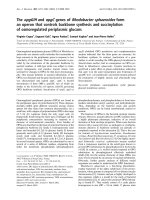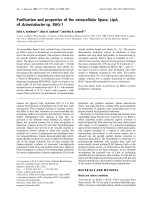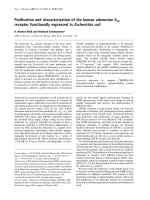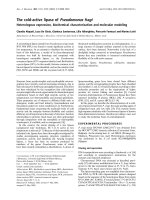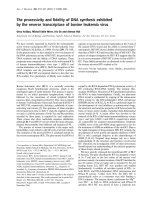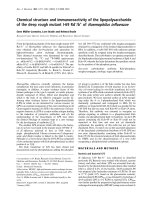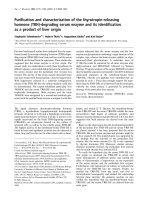Báo cáo y học: "The infectivity and pathogenicity of a foot-and-mouth disease virus persistent infection strain from oesophageal-pharyngeal fluid of a Chinese cattle in 2010" potx
Bạn đang xem bản rút gọn của tài liệu. Xem và tải ngay bản đầy đủ của tài liệu tại đây (384.71 KB, 11 trang )
This Provisional PDF corresponds to the article as it appeared upon acceptance. Fully formatted
PDF and full text (HTML) versions will be made available soon.
The infectivity and pathogenicity of a foot-and-mouth disease virus persistent
infection strain from oesophageal-pharyngeal fluid of a Chinese cattle in 2010
Virology Journal 2011, 8:536 doi:10.1186/1743-422X-8-536
Hui-Fang Bao ()
Dong Li ()
Pu Sun ()
Qiang Zhou ()
Jun Hu ()
Xing-Wen Bai ()
Yuan-Fang Fu ()
Zeng-Jun Lu ()
Zai-Xin Liu ()
ISSN 1743-422X
Article type Short report
Submission date 4 July 2011
Acceptance date 14 December 2011
Publication date 14 December 2011
Article URL />This peer-reviewed article was published immediately upon acceptance. It can be downloaded,
printed and distributed freely for any purposes (see copyright notice below).
Articles in Virology Journal are listed in PubMed and archived at PubMed Central.
For information about publishing your research in Virology Journal or any BioMed Central journal, go
to
/>For information about other BioMed Central publications go to
/>Virology Journal
© 2011 Bao et al. ; licensee BioMed Central Ltd.
This is an open access article distributed under the terms of the Creative Commons Attribution License ( />which permits unrestricted use, distribution, and reproduction in any medium, provided the original work is properly cited.
The infectivity and pathogenicity of a foot-
and-mouth disease virus persistent infection
strain from oesophageal-pharyngeal fluid of a
Chinese cattle in 2010
ArticleCategory :
Short Report
ArticleHistory :
Received: 04-July-2011; Accepted: 02-December-2011
ArticleCopyright
:
© 2011 Bao et al; licensee BioMed Central Ltd. This is an Open
Access article distributed under the terms of the Creative Commons
Attribution License (
which permits unrestricted use, distribution, and reproduction in any
medium, provided the original work is properly cited.
Hui-Fang Bao,
Aff1
Email:
Dong Li,
Aff1
Corresponding Affiliation: Aff1
Phone: +86-931-8343390
Email:
Pu Sun,
Aff1
Email:
Qiang Zhou,
Aff1
Email:
Jun Hu,
Aff2
Email:
Xing-Wen Bai,
Aff1
Email:
Yuan-Fang Fu,
Aff1
Email:
Zeng-Jun Lu,
Aff1
Email:
Zai-Xin Liu,
Aff1
Corresponding Affiliation: Aff1
Phone: +86-931-8342587
Fax: +86-931-8342587
Email:
Aff1
State Key Laboratory of Veterinary Etiologic Biology, Key
laboratory of Animal Virology of Ministry of Agriculture, National
Foot
-
and
-
Mouth Disease Referenc
e Laboratory of China, Lanzhou
Veterinary Research Institute, Chinese Academy of Agricultural
Sciences, Lanzhou, Gansu 730046, China
Aff2
Xinjiang Animal health supervision Institute, Urumuqi 830060,
China
Abstract
Background
Foot-and mouth disease (FMD) is an acute, febrile, and contagious vesicular disease affecting
cloven-hoofed animals. Some animals may become persistent infected carriers when they
contact FMD virus (FMDV), and persistent infected animals are a dangerous factor to cause
FMD outbreak.
Findings
300 OP (oesophageal-pharyngeal) fluid samples were collected from cattle without clinic
symptom after one month FMD circulated in 2010 in China. A FMDV strain was isolated
when a positive OP sample was passed in BHK21 cell line. The strain, named
O/CHN/2010/33-OP, was detected to be O/Myanmar/1998 lineage with VP1 DNA sequence
comparison. In order to testify its infectivity, two cattle were challenged with OP fluid and
three pigs were put into the same pen for direct contact infection. The result showed that one
of the cattle and one of the pigs appeared FMD clinic symptoms respectively. Furthermore,
two cattle (three pigs were also put into the same pen for direct contact infection) and three
pigs were inoculated with O/CHN/2010/33-OP cell passaged strain. The result showed that
one of the challenged pigs appeared FMD clinic symptoms. Two cattle and three pigs in the
same pen did not appeared FMD clinic symptoms, but the sera antibody and their OP fluid of
two cattle were positive. Meanwhile, the spinal cords of three pigs in the same pen with two
cattle were positive detected with multiplex- RT-PCR.
Conclusion
The persistent infection strain O/CHN/2010/33-OP has infectivity and pathogenicity to cattle
and pigs, and infected cattle may transmit the virus to pigs although its virulence was lower
than the circulated strain O/CHN/Mya98/2010.
Keywords
Foot-and-mouth disease virus (FMDV), Persistent infection strain, Oesophageal-pharyngeal
fluid, Infectivity, Pathogenicity
Findings
Foot-and mouth disease is an acute, febrile, and contagious vesicular disease affecting
cloven-hoofed animals. Some animals may become persistent infected carriers when they
contact FMDV. Van Bekkum detected FMDV aperiodically from oesophageal-pharyngeal
sites of cattle without FMD clinic symptoms and gave a concept “persistent infection” [1].
Dave bred some healthy cattle with FMDV-carried ones for several months and the healthy
cattle were infected by the same FMDV strain [2]. Another example is that the origin of FMD
circulation in Chinese Taiwan in 1999 was FMDV persistent infection carrier of cattle [3]
.Therefore, persistent infected animals are a dangerous factor to cause FMD outbreak.
In recent years, Some Asian countries such as China, Mongolia, Korea, Japan populated
FMD which were all caused by the O/Myanmar/1998 lineage strain [4,5]. Three hundred OP
(oesophageal-pharyngeal) fluid samples were collected from cattle without clinic symptom
after one month FMD circulated in 2010 in Xinjiang province of China. A persistent infection
strain O/CHN/2010/33-OP was isolated from an OP fluid sample (Figure 1). In this report,
we evaluated the infectivity and pathogenicity to cattle and pigs of the strain, and compared
the virulence between O/CHN/2010/33-OP and a circulated strain O/CHN/Mya98/2010.
Figure 1 The test result by multiplex-RT-PCR. Line 1 and line 2 were two negative samples;
line 3 was positive sample; M was DNA marker ladder
The positive FMDV OP fluid tested with multiplex-RT-PCR was propagated in baby hamster
kidney (BHK21) cells serially for seven passages, and the supernatants of infected cells were
filtered and stored at −70°C, named O/CHN/2010/33-OP cell strain(1.3×10
7.0
PFU/mL).
Another cattle tongue FMDV sample was treated with the same way to propagate in BHK21
cells and stored at−70°C, named O/CHN/Mya98/2010 cell strain (1.0×10
7.0
PFU/mL).
Total RNA was extracted from samples, using RNeasy Mini kits (QIAGEN) following the
manufacturer’s instructions. RNA was reverse transcribed into cDNA and amplified using
one step RT-PCR kit(TaKaRa).Two primers 1D2(5′-GCG CTG GCA AAG ACT TTG A- 3′)
and 1D5(5′-GAC ATG TCC TCC TGC ATC TGG TTG A- 3′) were needed for VP1 gene’s
amplification. The PCR products were purified and sequenced (Sunny Biologic Company,
Shanghai, China).
FMDV type O VP1 gene reference sequences were obtained from Genbank on the National
Center for Biotechnology Information (NCBI) website (www.ncbi.nlm.nih.gov). Multiple
sequence alignments were analyzed and percent identities were showed (Figure 2) using the
MegAlign project of DNAStar software package (www.dnastar.com). The strains, named
O/CHN/2010/33-OP and O/CHN/Mya98/2010, were detected to be O/Myanmar/1998
lineage.
Figure 2 Multiple sequence alignments using the MegAlign project of DNAStar software
package
Five groups of animals (Official experimental license number:SYXK[Gansu, China]2010-
0003)were used(twelve 2-month-old healthy pigs and six 1-year-old healthy cattle, sero-
negative for FMDV) in five separate pens to test the infectivity and pathogenicity of
O/CHN/2010/33-OP and O/CHN/Mya98/2010. All infected animals were observed daily for
14 days post inoculation (d.p.i.) before they were slaughtered to collect OP fluids and lymph
nodes and spinal cords for virus detection with multiplex- RT-PCR. The first day was
recorded at 24 h p.i. (Table 1).
Table 1 The infectivity and pathogenicity of O/CHN/2010/33-OP
Group
Infected
strain
Animals dpi
Clinic
symptom
Virus
in OP
fluid
Virus in
lymph
nodes
Virus in
spinal
cords
3ABC
NSP Ab
Type O
SP Ab
(LPB-ELISA )
8 + + 1:720 cattle
No.134
14 + + + + 1:1024
8 - - + 1:360
O/CHN/
2010/
33-OP
OP fluid
cattle
No.184
14 - - + + 1:1024
8 - - <1:4
11 + - 1:90
pig
No.036
14 + + + 1:512
8 - - <1:4
11 - - 1:45
pig
No.039
14 - + - 1:180
8 - - 1:6
11 - - 1:45
Group 1
Direct
contact
infection
pig
No.040
14 - + - 1:128
8 - + 1:90
11 - + 1: 90
Group 2 O/CHN/2
010/
33-OP cell
strain
cattle
No.3
14 - + + + 1: 180
8 - - 1:32
11 - - 1:90
strain
cattle
No.146
14 - + + + 1:128
8 - - 1:4
11 - - 1:4
pig
No.041
14 - + - 1:16
8 - - 1:12
11 - - 1:6
pig
No.046
14 - + - 1:6
8 - - 1:4
11 - - 1:6
Direct
contact
infection
pig
No.049
14 - + - 1:6
4 + / /
5 + / /
pig
No.029
14 + + + 1:180
4 - / /
5 - / /
pig
No.032
14 - + + 1:512
4 - / /
5 - / /
Group 3
O/CHN/
2010/
33-OP
cell strain
pig
No.033
14 - + + 1:128
Group 4 O/CHN/M
cattle 5 - / /
8 - - 1:32 No.11
14 + + + 1:256
5 + - 1:90
8 + + /
(control)
ya98/
2010 cell
strain
cattle
No.12
14 + + + 1:180
5 - / /
8 - / /
pig
No.047
14 - + + 1:180
5 - / /
8 + - 1:45
pig
No.048
14 + + + 1:360
5 + / /
8 + - 1:180
Group 5
(control)
O/CHN/M
ya98/
2010 cell
strain
pig
No.050
14 + + + 1:360
Note: /:undetected +:positive -:negative
dpi : days post infection NSP: nonstructural protein SP: structural protein
Ab: Antibody
In the first group, two cattle (No.134, 184) were injected 0.6 ml positive OP fluid in the
surface of their tongue respectively, and three pigs(No.036,039,040) were bred in the same
pen. One of the cattle (No.134) developed blister in the foot on the day 8 p.i The sera titer of
both cattle was 1:1024 on the day 14 p.i. although No.184 did not show clinic symptom. Pig
No.036 developed blister on the day 11 p.i The sera titer of three pigs were 1:512,1:180,
1:128 respectively on the day 14 p.i They were all positive.
In the second group, two cattle (No.3, 146) were injected 2 ml O/CHN/2010/33-OP cell strain
in the surface of their tongue respectively, and three pigs (No.041, 046, 049) were bred in the
same pen. The OP fluids of both cattle were positive on the day 14 p.i. although clinic
symptoms did not appear. The sera titer of both cattle was 1:180 and 1:128 on the day 14 p.i
Lymph nodes and spinal cords of three pigs were FMDV positive although clinic symptoms
did not appear on the day 14 p.i
In the third group, three pigs (No.029, 032, 033) were injected 2 ml O/CHN/2010/33-OP cell
strain into one heel bulb and into the ear-root-neck area respectively. Pig No.029 developed
primarily blister in the injected foot on the day 4 p.i. and developed secondary blister in
another foot on the day 5 p.i Its sera titer was 1:180. The sera titer of pigs No.032 and
No.033 was 1:512, 1:128 respectively although clinic symptoms did not appear.
In the fourth group, two cattle (No.11, 12) were injected 2 ml O/CHN/Mya98/2010 cell strain
in the surface of their tongue respectively. Both cattle developed blister.
In the fifth group, three pigs (No.047, 048, 050) were injected 2 ml O/CHN/Mya98/2010 cell
strain into one heel bulb and into the ear-root-neck area respectively. Only pig No.047 did not
appear clinic symptom. Other two pigs developed blister on the day 5~7 p.i
From above experimental result, the persistent infection strain O/CHN/2010/33-OP may
infect other cattle and pigs. That FMDVs were found out from spinal cords of five direct
contact infected pigs (group 1 and group 2) means the virus transmitted from cattle to pigs,
and one pig appeared blister means the virus has pathogenicity and can lead to illness of pig.
One cattle appeared blister in group 1 when injected OP fluid containing virus. The possible
reason was that individual difference may induce some cattle’s clinic symptom but some not.
This suggested that the persistent infection strain O/CHN/2010/33-OP can infect the same
type of animals.
The pathogenicity of the persistent infection strain O/CHN/2010/33-OP was weaker than the
popular strain O/CHN/Mya98/2010. Two cattle (group 2) inoculated with the
O/CHN/2010/33-OP cell strain did not appear clinic symptom but other two ones (group 4)
infected with the popular strain O/CHN/Mya98/2010 developed blister. Meanwhile, only one
of three pigs (group 3) infected with the O/CHN/2010/33-OP cell strain appeared clinic
symptom but two of three pigs (group 5) infected with the popular strain
O/CHN/Mya98/2010 appeared clinic symptom. The dose and quantity of the inoculated virus
was the same. These data demonstrated that the virulence of the persistent infection strain
O/CHN/2010/33-OP was lower than the popular strain O/CHN/Mya98/2010, which was
similar with a previous report about another FMDV persistent infection strain [6].
In brief, the persistent infection strain O/CHN/2010/33-OP has infectivity and pathogenicity
to cattle and pigs,so it is very important to detect FMD persistent infected animals and
eliminate carriers in order to control outbreak of FMD.
Competing interests
The authors declare that they have no competing interests.
Authors’ contributions
ZXL was responsible for the research. HFB, DL and PS carried out most of the experiments.
DL wrote and revised the manuscript. JH, QZ, XWB, YFF, ZJL carried out part of the
experiment. All of the authors read and approved the final version of the manuscript.
Acknowledgement
This work has been supported by a fund from Ministry of Agriculture of China for animal
disease control in border areas (Contract No. 201103008) and a fund from Lanzhou city R
&D programme (2010-1-175).
References
1. Van Bekkum JG, Frenkel HS, Frederiks HHJ: Observations on the carrier state of
cattle exposed to foot-and-mouth disease virus. Bull Int Epizoot 1959, 51:917–922.
2. Dawe PS, Sorensen K, Frris NP: Experimental transmission of foot-and-mouth
disease from African buffalo to cattle in Zimbabwe. Vet Rec 1994, 149:30–31.
3. Chin-Cheng Huang,Yeou-Liang Lin, Ten-Shiang Huang, et al: Molecular
characterization of foot-and-mouth disease virus isolated from ruminants in
Taiwan in 1999–2000. Vet Microbiol 2001, 81:193–205.
4. Paton DJ, King DP, Knowles NJ, et al: Recent spread of foot-and-mouth disease in
the Far East. Vet Rec 2010, 166:569–570.
5. BAI XingWen, LI PingHua, BAO HuiFang,et al: Evolution and molecular
epidemiology of foot-and-mouth disease virus in China. Chin Sci Bull, 2011,
56(1):1–11.
6. Kaaden O, Eissner G, Bohm HO: Studies on permanent virus excretors in cattle
vaccinated and experimentally infected with foot-and-mouth disease. Anim Res
Dev 1975,1:20–33.
Figure 1
Fig.2 Multiple sequence alignments using the MegAlign project of DNAStar software
package
Figure 2



